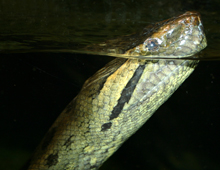Description: The primary color of Green anacondas (Eunectes murinus) is olive green, with black blotches running down the body. Their narrow head (as compared to the rest of the body) has an orange-yellow striping on either side. The eyes and nostrils are positioned on the top of the head, enabling them to breathe and to see without exposing their body.
Size: They are among the largest snakes in the world, with recorded measurements of 27-32 feet (8-9.8 m), with average size being 18 feet (5.5 m); can weigh as much as 500 pounds (227 kg) with a diameter of 12 inches ( 30.5 cm). Females are significantly larger than males. Anacondas are the heaviest snake, but the Reticulated python may be longer.
Behavior: They are nocturnal and spend much of the time in the water. Known as the “water boa”, they are capable of surprising speeds both on the surface of the water and under water, but slow on land.
Diet: Green anacondas are primarily aquatic. They eat almost anything they can manage to overpower – fish, birds, mammals and other reptiles. Using constriction to subdue their prey, they may capture large animals such as tapir, deer, capybara, caiman, crocodiles and Jaguars.
Senses: Anacondas have heat-sensing pits along the lips that can detect the body heat given off by warm-blooded animals even in dark conditions. Jacobson’s organ, a special smelling organ on the
roof of the mouth deciphers the chemical clues collected by the snake’s flicking tongue. An anaconda’s hearing is limited, but it may detect sounds and vibrations.
Communication: Communication to attract a mate involves emitting scented pheromones by females and tactile stimulation by males. Defensive communication by young anacondas is believed to involve curling up in a ball and making hissing sounds.
Reproduction: Courtship and copulation takes place during the rainy season, typically in the water. Females emit pheromones to attract males. Several males will cluster into a “breeding ball” by twining around the much larger female (which may continue for two to four weeks). Gestation is approximately six months. Litter size averages 20-40 young, but as many as 100 are possible. Sexual maturity is reached between two and three years of age (males reach sexual maturity earlier than females). Anacondas are ovoviviparous (they retain eggs internally until the young hatch). At birth, a membrane surrounds them, which breaks at delivery and allows the young to move away from the mother. While they are carrying eggs inside, females usually do not eat.
Habitat/range: Green anacondas prefer swamps and calmer waters over swift-moving rivers. They are mainly found in northern South America (Amazon and Orinoco basins).
Status: Not threatened; not evaluated.



